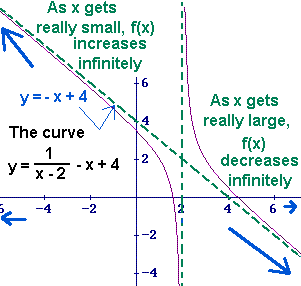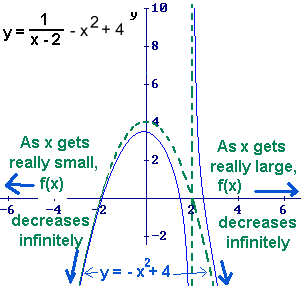
When x is extremely large, the values of f(x) are close to the values of y = 0,
so, f(x) is positive and approximately 0.
When x is extremely small, the values of f(x) are close to the values of y = 0,
so, f(x) negative and approximately 0.

When x is extremely large, the values of f(x) are close to the values of y = 4,
so, f(x) is approximately 4.
When x is extremely small, the values of f(x) are close to the values of y = 4,
so, f(x) negative and approximately 4.

When x is extremely large, the values of f(x) are close to the values of y = -x + 4,
which is increasing infinitely, so, f(x) is increasing to positive infinitely.
When x is extremely small, the values of f(x) are close to the values of y = -x + 4,
which is decreasing infinitely, so, f(x) is decreasing to negaive infinity.

When x is extremely large, the values of f(x) are close to the values of y = - x² + 4,
which is increasing infinitely, so, f(x) is decreasing to negaive infinitely.
When x is extremely small, the values of f(x) are close to the values of y = - x² + 4,
which is decreasing infinitely, so, f(x) is decreasing to negaive infinity.



![[MC,i. Home]](http://www.mathnstuff.com/math/spoken/here/1gif/mcihome.gif)
![[Table]](http://www.mathnstuff.com/math/spoken/here/1gif/table.gif)
![[Words]](http://www.mathnstuff.com/math/spoken/here/1gif/words.gif)

![[this semester's schedule w/links]](http://www.mathnstuff.com/gif/semestr.gif)
![[Good Stuff -- free & valuable resources]](http://www.mathnstuff.com/gif/goods.gif)
![[next]](http://www.mathnstuff.com/math/spoken/here/1gif/next.gif)
![[last]](http://www.mathnstuff.com/math/spoken/here/1gif/last.gif)